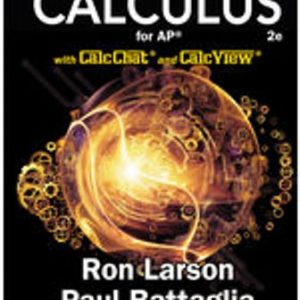Description
Mathematics for Machine Technology 9th Edition Peterson – Test Bank
Test Bank for Mathematics for Machine Technology, 9th Edition, John C. Peterson, Kathleen A. McGarry, Robert D. Smith, ISBN: 9798214116457
Table of Contents
SECTION I: COMMON FRACTIONS AND DECIMAL FRACTIONS.
1. Introduction to Common Fractions and Mixed Numbers.
2. Addition of Common Fractions and Mixed Numbers.
3. Subtraction of Common Fractions and Mixed Numbers.
4. Multiplication of Common Fractions and Mixed Numbers.
5. Division of Common Fractions and Mixed Numbers.
6. Combined Operations of Common Fractions and Mixed Numbers.
7. Introduction to Decimal Fractions.
8. Rounding Decimal Fractions and Equivalent Decimal and Common Fractions.
9. Addition and Subtraction of Decimal Fractions.
10. Multiplication of Decimal Fractions.
11. Division of Decimal Fractions.
12. Powers.
13. Roots.
14. Table of Decimal Equivalents and Combined Operations of Decimal Fractions..
15. Achievement Review Section One.
SECTION II: RATIO, PROPORTION, AND PERCENTAGE.
16. Ratio and Proportion.
17. Direct and Inverse Proportions.
18. Introduction to Percents.
19. Basic Calculations of Percentages, Percents, and Rates.
20. Percent Practical Applications.
21. Achievement Review Section Two
SECTION III: LINEAR MEASUREMENT: CUSTOMARY (ENGLISH) AND METRIC.
22. Customary (English) Units of Measure.
23. Metric Units of Linear Measure.
24. Degree of Precision and Greatest Possible Error, Absolute Error, and Relative Error.
25. Tolerance, Clearance, and Interference.
26. Customary and Metric Steel Rules.
27. Customary Vernier Calipers and Height Gages.
28. Metric Vernier Calipers and Height Gages.
29. Digital Calipers and Height Gages.
30. Customary Micrometers.
31. Metric Vernier Micrometers.
32. Digital Micrometers.
33. Customary and Metric Gage Blocks.
34. Achievement Review Section Three.
SECTION IV: FUNDAMENTALS OF ALGEBRA.
35. Symbolism and Algebraic Expressions.
36. Signed Numbers.
37. Algebraic Operations of Addition, Subtraction, and Multiplication.
38. Algebraic Operations of Division, Powers, and Roots.
39. Introduction to Equations.
40. Solution of Equations by the Subtraction, Addition, and Division Principles of Equality.
41. Solution of Equations by the Multiplication, Root, and Power Principles of Equality.
42. Solution of Equations Consisting of Combined Operations and Rearrangement of Formulas.
43. Applications of Formulas to Cutting Speed, Revolutions Per Minute, and Cutting Time.
44. Applications of Formulas to Spur Gears.
45. Achievement Review Section FOUR.
SECTION V: FUNDAMENTALS OF PLANE GEOMETRY.
46. Lines and Angular Measure.
47. Protractors- Simple Semicircular and Vernier.
48. Types of Angles and Angular Geometric Principles.
49. Introduction to Triangles.
50. Geometric Principles for Triangles and Other Common Polygons.
51. Introduction to Circles.
52. Arcs and Angles of Circles, Tangent Circles.
53. Fundamental Geometric Constructions.
54. Achievement Review Section Five.
SECTION VI: GEOMETRIC FIGURES: AREAS AND VOLUMES.
55. Areas of Rectangles, Parallelograms, and Trapezoids.
56. Areas of Triangles.
57. Areas of Circles, Sectors, and Segments.
58. Volumes of Prisms and Cylinders.
59. Volumes of Pyramids and Cones.
60. Volumes of Spheres and Composite Solid Figures.
61. Achievement Review Section Six.
SECTION VII: TRIGONOMETRY.
62. Introduction to Trigonometric Functions.
63. Analysis of Trigonometric Functions.
64. Basic Calculations of Angles and Sides of Right Triangles.
65. Simple Practical Machine Applications.
66. Complex Practical Machine Applications.
67. The Cartesian Coordinate System.
68. Oblique Triangles: Law of Sines and Law of Cosines.
69. Achievement Review Section Seven.
SECTION VIII: COMPOUND ANGLES.
70. Introduction to Compound Angles.
71. Drilling and Boring Compound-Angular Holes: Computing Angles of Rotation and Tilt Using Given Lengths.
72. Drilling and Boring Compound-Angular Holes: Computing Angles of Rotation and Tilt Using Given Angles.
73. Machining Compound-Angular Surfaces: Computing Angles of Rotation and Tilt.
74. Computing Angles Made by the Intersection of Two Angular Surfaces.
75. Computing Compound Angles on Cutting and Forming Tools.
76. Achievement Review Section Eight.
SECTION IX: COMPUTER NUMERICAL CONTROL: (CNC).
77. Introduction to Computer Numerical Control (CNC).
78. Control Systems, Absolute Positioning, Incremental Positioning.
79. Location of Points: Polar Coordinate System.
80. Binary Numeration System.
81. Hexadecimal Numeration System.
82. BCD (Binary Coded Decimal) Numeration Systems.
83. An Introduction to G- and M-Codes for CNC Programming
84. Achievement Review Section 9.






